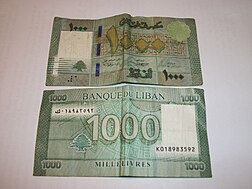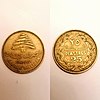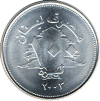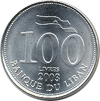Lebanese pound
| Lebanese pound | |
|---|---|
| ليرة لبنانية (Arabic) Livre libanaise (French) | |
 LL1,000 note, written in Arabic on one side and French on the other side | |
| ISO 4217 | |
| Code | LBP |
| Denominations | |
| Subunit | |
| 1⁄100 | piastre |
| Symbol | LL and ل.ل. |
| Banknotes | LL1,000, LL5,000, LL10,000, LL20,000, LL50,000, LL100,000 |
| Coins | LL25, LL50, LL100, LL250, LL500 |
| Demographics | |
| User(s) | |
| Issuance | |
| Central bank | Banque du Liban |
| Website | www |
| Valuation | |
| Inflation | 84.9% |
| Source | The Global Economy, 2020 |
| Pegged with | U.S. dollar $1 US = 1507 LBP[1] Black market exchange rate has diverged significantly; see article text |
The Lebanese pound (Arabic: ليرة لبنانية līra Libnāniyya; French: livre libanaise; sign: LL in Latin, ل.ل. in Arabic, ISO 4217: LBP) is the currency of Lebanon. It was formerly divided into 100 piastres (or qirsh) but because of high inflation during the Lebanese Civil War (1975–1990) the use of subdivisions was discontinued.
The plural form of lira, as used in relation to the currency, is either lirat (ليرات līrāt) or invariant, whilst there were four forms for qirsh: the dual qirshān (قرشان) used with number 2, the plural qurush (قروش) used with numbers 3–10, the accusative singular qirshan (قرشا) used with 11–99, and the genitive singular qirshi (قرش) used with multiples of 100. The number determines which plural form is used. Before World War II, the Arabic spelling of the subdivision was غرش (girsh). All of Lebanon's coins and banknotes are bilingual in Arabic and French.
Since December 1997, the exchange rate has been fixed at LL1,507.5 per USD.[2] However since the 2020 economic crisis in Lebanon exchange at this rate is generally unavailable, and an informal currency market has developed with much higher exchange rates.[3]
History[]
Until World War I, the Ottoman lira was the currency used in the area. In 1918, after the fall of the Ottoman Empire, the Egyptian pound was used. Upon gaining control of Syria and Lebanon, the French replaced the Egyptian pound with a new currency for Syria and Lebanon, the Syrian pound, which was linked to the French franc at a value of 1 pound = 20 francs. Lebanon issued its own coins from 1924 and banknotes from 1925. In 1939, the Lebanese currency was officially separated from that of Syria, though it was still linked to the French franc and remained interchangeable with Syrian money. In 1941, following France's defeat by Nazi Germany, the currency was linked instead to Sterling at a rate of LL8.83 = £1Stg.[4] A link to the French franc was restored after the war, but was abandoned in 1949.
Before the third phase of the Lebanese Civil War, US$1 was worth:
- LL3.07 in 1965
- LL3.26 in 1970
- LL2.25 in 1975
- about LL4 in 1981
During the Civil War, the value decreased rapidly until 1992, when one US dollar was worth over LL2,500. Subsequently the value increased again, and since December 1997 the official rate has been fixed at LL1507.5 = US$1.[2]
In August 2019, pressure on the fixed exchange rate with the U.S. dollar started, creating a parallel market rate. The two-rate market is a textbook case of weakening central bank reserves that are not able to defend the official exchange rate.[citation needed] Continuous financial pressures driven by unsustainable sovereign debt, high trade deficit and deposit outflows due to loss of confidence are threatening the peg for the first time since 1992.[citation needed]
As of 3 March 2021, the black market rate in Beirut was LL10,000 = 1 U.S. dollar.[5] By July 2021, it was around LL24,000 to the dollar.[6]
Coins[]
Lebanon's first coins were issued in 1924 in denominations of 2 and 5 girush (note the different spelling from post WWII coins) with the French denominations given in "piastres syriennes", Syrian piastres). Later issues did not include the word "syriennes" and were in denominations of 1⁄2pt, 1pt, 2pt, 2+1⁄2pt, 5pt, 10pt, 25pt and 50pt. During World War II, rather crude 1⁄2pt, 1 and 2+1⁄2pt coins were issued.
After the war, the Arabic spelling was changed from girsh (غرش) to qirsh (قرش). Coins were issued in the period 1952 to 1986 in denominations of 1pt, 2+1⁄2, 5pt, 10pt, 25pt, 50pt and LL1. No coins were issued between 1986 and 1994, when the current series of coins was introduced.
Coins in current use are:[7]
| Coins of the Lebanese Pound | ||||||||
|---|---|---|---|---|---|---|---|---|
| Image | Value | Technical parameters | Color | Date of issue | ||||
| Obverse | Reverse | Diameter | Thickness | Mass | Metal | |||
| Coins no longer in circulation[8] | ||||||||
| 5pt | 18 mm | 2.2 g | Copper-nickel-aluminium | Golden yellow | 1968 1969 1972 1975 | |||
| 10pt | 21 mm | 3.2 g | Copper-nickel-aluminium | Golden yellow | 1968 1969 1970 1972 1975 | |||

|
25pt | 23.5 mm | 4 g | Copper-nickel-aluminium | Golden yellow | 1968 1969 1970 1972 1975 1980 | ||

|
50pt | 24 mm | 6 g | Nickel | White nickel | 1968 1969 1970 1971 1975 1978 1980 | ||
| LL1 | 27.5 mm | 8 g | Nickel | White nickel | 1975 1977 1980 1981 | |||
| 27 mm | 7.22 g | Nickel-plated steel | White nickel | 1986 | ||||
| Coins in circulation[7] | ||||||||
| LL25 | 20.5 mm | 1.3 mm | 2.8 g | Nickel-plated steel | White nickel | 2002 | ||

|
LL50 | 19 mm | 1.15 mm | 2.25 g | Stainless steel | White nickel | 1996 | |
| 21.5 mm | 1.67 mm | 3g | Nickel-plated steel | 2006 | ||||

|

|
LL100 | 22.5 mm | 1.80 mm | 4 g | Zinc and copper | Red copper | 1995 1996 2000 |

|

|
LL100 | 22.5 mm | 1.83 mm | 4 g | Steel and nickel | White | 2003 |
| LL100 | 22.5 mm | 1.80 mm 1.60 mm |
4 g | Steel and copper | Red copper | 2006 2009 | ||

|

|
LL250 | 23.5 mm | 1.82 mm | 5 g | Copper and aluminium | Yellow gold | 1995 1996 2000 2003 |
| 1.65 mm | Nordic Gold | Nordic Gold | 2006 2009 2012 | |||||

|

|
LL500 | 24.5 mm | 2.05 mm | 6 g | Nickel-plated steel | White | 1995 1996 2000 2003 2006 2009 2012 |
| For table standards, see the coin specification table. | ||||||||
Banknotes[]
This section needs expansion with: Obverse and Reverse presentations on the listed notes. You can help by . (November 2019) |

Lebanon's first banknotes were issued by the Banque du Syrie et Grand-Liban (Bank of Syria and Greater Lebanon) in 1925. Denominations ran from 25 girsha through to LL100. In 1939, the bank's name was changed to the Bank of Syria and Lebanon. The first LL250 notes appeared that year. Between 1942 and 1950, the government issued "small change" paper money in denominations of 5, 10, 25 and 50 girsh or qirsh (the change in spelling occurred during these years). After 1945, the Bank of Syria and Lebanon continued to issue paper money for Lebanon but the notes were denominated specifically in "Lebanese pounds" (ليرة لبنانية, livre libanaise) to distinguish them from Syrian notes. Notes for LL1, LL5, LL10, LL25, LL50 and LL100 were issued.
The Banque du Liban (Bank of Lebanon) was established by the Code of Money and Credit on 1 April 1964.[9] On 1 August 1963 decree No. 13.513 of the "Law of References: Banque Du Liban 23 Money and Credit" granted the Bank of Lebanon the sole right to issue notes in denominations of LL1, LL5, LL10, LL25, LL50, LL100, and LL250, expressed in Arabic on the front, and French on the back. Higher denominations were issued in the 1980s and 1990s as inflation drastically reduced the currency's value.
Banknotes in current use are:
| Circulating banknotes[10] | ||||
|---|---|---|---|---|
| Image | Value | Dimensions | Main color | Date of issue |
| LL1,000 | 156 × 67 mm | Teal | 1988 1990 1991 1992 | |
| 115 × 60 mm | 2004 2008 | |||
| 2011 2012 | ||||
| LL5,000 | 156 × 67 mm | Pink | 1994 1995 | |
| 140 × 70 mm | 1999 2001 | |||
| 120 × 62 mm | 2004 2008 | |||
| 2012 | ||||
| LL10,000 | 145 × 73 mm | Yellow | 1998 | |
| 127 × 66 mm | 2004 2008 | |||
| 2012 | ||||
| LL20,000 | 150 × 80 mm | Red | 1994 1995 2001 | |
| 130 × 72 mm | 2004 | |||
| 2012 | ||||
| LL50,000 | 150 × 80 mm | Blue | 1994 1995 1999 2001 | |
| 140 × 77 mm | 2004 | |||
| 2011 2012 | ||||
| LL100,000 | 161 × 90 mm | Green | 1994 1995 1999 2001 | |
| 147 × 82 mm | 2004 | |||
| 2011 2012 | ||||
| For table standards, see the banknote specification table. | ||||
All current notes feature an Arabic side with the value in Arabic script numerals of large size. The other side is in French with the serial number in both Arabic and Latin script and in bar code below the latter one.
Devaluation[]

Since September 2019, the exchange rate has forked into multiple distinct rates due to Lebanon's banking sector collapse. Within six months, six distinct Lebanese pound rates were defined against the US dollar, officially and unofficially. They were valued at:
- Official government rate = LL1,507.5
- Official syndicate rate = LL3,850–LL3,900
- "Lollar" (bank withdrawals of USD in LBP) = LL3,900
- Parallel market rate = LL3,800
- Banker's cheque rate = 10.85c/$
- Black market rate = LL30,000 (by jan 2022) [11]
Lollar[]
A Lollar is a Lebanese dollar, or a US dollar which is stuck in the banking system, really just a computer entry with no corresponding currency.
Dan Azzi
The "Lollar" is a deposit denominated in US dollars in the Lebanese banking system. It is a nominal balance stuck or frozen in the Lebanese banks, with currency value simply as a computer entry. The Lollar is not a tangible currency, but is a concept of an outstanding deposit in US dollars in Lebanese banks that can only be withdrawn in Lebanese pounds at a very reduced set rate[12] and considerably lower than the highly speculative black market rate which is multiple times higher. There are also limits put on the total amount that can be withdrawn on the lollars. The symbol of the lollar is lol.[13][14] The term was coined by Harvard University economic fellow Dan Azzi[15] after the Lebanese banks suffered serious difficulties and restricted the amount of US dollars and other foreign currencies they could pay to their depositors.
See also[]
| Current LBP exchange rates | |
|---|---|
| From Google Finance: | AUD CAD CHF EUR GBP HKD JPY USD USD |
| From Yahoo! Finance: | AUD CAD CHF EUR GBP HKD JPY USD USD |
| From XE.com: | AUD CAD CHF EUR GBP HKD JPY USD USD |
| From OANDA: | AUD CAD CHF EUR GBP HKD JPY USD USD |
| From fxtop.com: | AUD CAD CHF EUR GBP HKD JPY USD USD |
References[]
- ^ "About Banque du Liban | History of Banque du Liban". www.bdl.gov.lb. Retrieved 13 June 2016.
- ^ a b "Economic & Financial Data". Banque du Liban. Archived from the original on 2013-03-12. Retrieved 2013-02-10.
- ^ "Lebanese banks raise USD withdrawal rate to 3,850 pounds/dollar". Reuters. 29 June 2020. Retrieved 1 July 2020.
- ^ "Payment Media, Banknotes and Coins – The Historical Development of the Lebanese Pound". Banque du Liban. Archived from the original on 2008-12-26. Retrieved 2008-12-31.
- ^ "Protesters shut down roads as Lebanon pound hits all-time low". France 24. 2021-03-03. Retrieved 2021-03-05.
- ^ Lebanon currency drops to new low as financial meltdown deepens
- ^ a b "Coins in Circulation". Banque du Liban. Retrieved 26 September 2020.
- ^ "Coins Out of Circulation". Banque du Liban. Retrieved 26 September 2020.
- ^ Linzmayer, Owen (2012). "Lebanon". The Banknote Book. San Francisco, CA: www.BanknoteNews.com.
- ^ "Banknotes in Circulation". www.bdl.gov.lb. Banque du Liban. Retrieved 26 September 2020.
- ^ "Freefalling Lebanese currency hits unprecedented new low". Al-Mayadeen. 14 December 2021. Retrieved 14 December 2021.
- ^ Heidi Moura (July 19, 2020). "Lebanese 'Lollars' – How American Currency Has Become The Face Of A Country's Downfall". The Organization for World Peace. Retrieved March 16, 2021.
- ^ Leyal Khalife (16 January 2020). "'LOLLAR' At Me: A term coined after the fall of the Lebanese banking system". Stepfeed. Retrieved March 17, 2021.
- ^ Finance4Lebanon: The Lollar
- ^ Souad Lazkani (January 25, 2021). "Lebanese Filmmaker Says You Can Change 'Lollars' To Dollars By Investing In Movies". the961.com. Retrieved March 16, 2021.
- Krause, Chester L.; Clifford Mishler (1991). Standard Catalog of World Coins: 1801–1991 (18th ed.). Krause Publications. ISBN 0873411501.
- Pick, Albert (1994). Standard Catalog of World Paper Money: General Issues. Colin R. Bruce II and Neil Shafer (editors) (7th ed.). Krause Publications. ISBN 0-87341-207-9.
External links[]
- ISO 4217
- Currencies of Asia
- Circulating currencies
- Pound (currency)
- Currencies of Lebanon
- Fixed exchange rate
- Currencies introduced in 1924